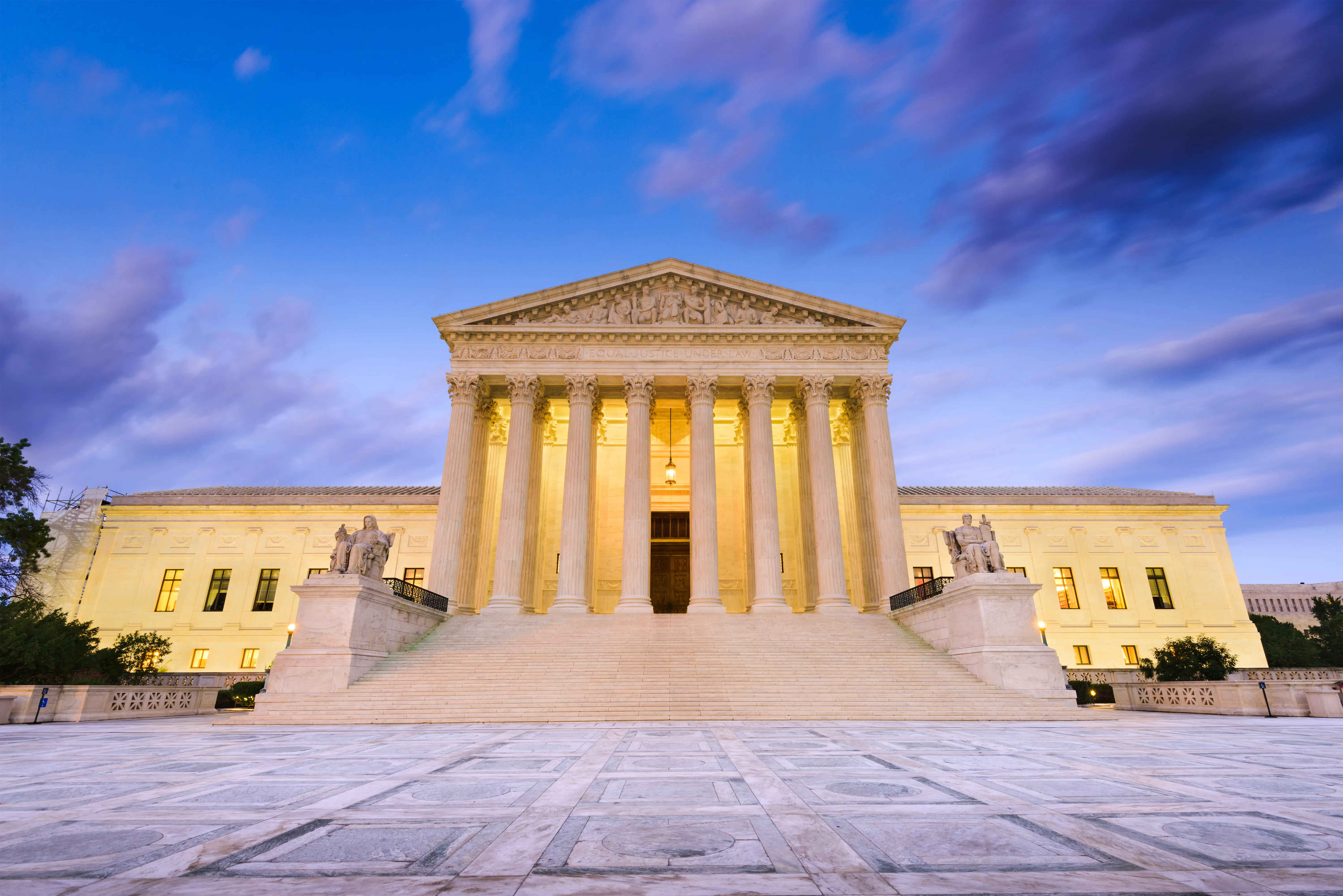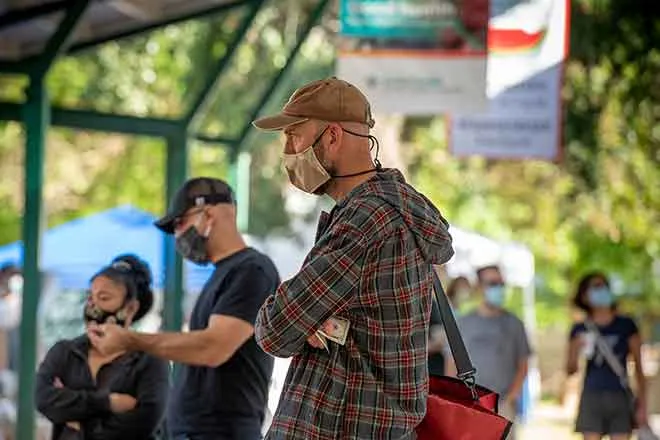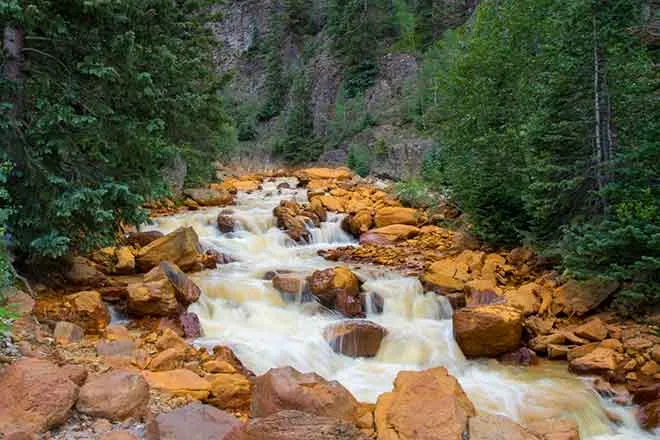
Post-wildfires, toxic smoke a lasting health concern in California
Click play to listen to an abbreviated version of this article.
This past February, chemist Pawel Misztal pulled his white Ford van onto the I-10 freeway, headed west from Austin, Texas, to southern California. The last embers of the massive Eaton and Palisades fires cooled as Misztal drove toward a devastated Los Angeles County. The Ford, an electric vehicle dubbed “the Sniffer Van,” was loaded with mass spectrometry instruments, made to measure even tiny amounts of air pollution released by the fires. Because it’s electric, the Sniffer Van doesn’t belch exhaust that contaminates samples (the signature from other traffic is clear and distinct). Its range is only 120 miles, so “we had to stop like 15 times,” Misztal says. He drove the 1,400 miles from Austin sometimes cruising in the slow lane, just under the speed limit with the air conditioning off, to stretch the van’s charge. On the fourth afternoon, he pulled into Altadena, where the Eaton Fire had crawled down the ridge of the San Gabriel Mountains and gobbled up much of the suburb. His first impression: “shock,” Misztal says. “It looks like a war zone.”
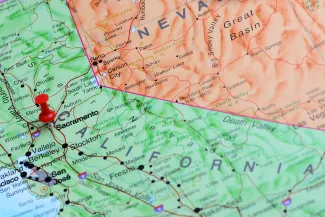
As Misztal cruised through the burned-out streets of Altadena, his instruments sucked in outdoor air through narrow polymer tubing to identify compounds. When Misztal drove by charred debris, or downwind of blackened houses, he saw spikes in various airborne chemicals on his laptop, whirring beside him on the passenger seat. That’s “the beauty of real-time data,” he says. The instruments draw air through an inlet on the back of the van, detecting short-lived spikes in some pollutants and overall background changes in others.
Over the next few weeks, in both Altadena and the Palisades, Misztal collected 300 gigabytes of data, capturing more than 1,000 different airborne compounds. Some were toxins, such as benzene, acetone, and carbonates released from burned cars and plastics. Just how dangerous might those compounds be? It depends on the dosage of exposure, Misztal says. He’s still processing the data, but says that the bottom line is “we don’t fully understand exposure and toxicity for a majority of compounds.”
Misztal’s research is part of a larger collaboration between multiple universities, including the Harvard T.H. Chan School of Public Health, the Universities of California Los Angeles and Davis, and Misztal’s home institution of the University of Texas at Austin. Called the Los Angeles Fire Human Exposure and Long-Term Health Study (LA Fire HEALTH Study), the goal is to evaluate the pollutants released by the January fires and the health impacts of those emissions. The project highlights a growing perspective on wildfires—that they’re not only natural disasters, but potentially major health disasters as well.
Toxic Brew
As devastating wildfires happen more often, the public breathes extreme levels of air pollution more frequently, says Mary Berlik Rice, a pulmonologist studying air pollution and climate at Harvard’s School of Public Health. Because of the stew of materials being burned, the toxins released in urban wildfires are potentially more carcinogenic and potentially deadlier than smoke from other wildfires, she says.

© iStock - Davizro
While few if any studies have quantified the relationship between long-term smoke exposure and cancer risk in humans, work in mice finds that wildfire smoke damages the lungs and increases inflammation (1). And a summary of workplace health risks for firefighters, published in The Lancet Oncology, finds that they have a significantly elevated risk of several cancers (2). Smoke also contains volatile organic compounds (VOCs) that have been linked to cancer at high levels. The health consequences of repeat exposure to low levels of VOCs—for instance, in neighboring Los Angeles (LA) suburbs or in faraway towns breathing smoke on the wind—isn’t yet clear.
What is clear is that fire makes air quality much worse. Even on a quiet weather and wildfire day, LA has some of the worst air quality in the country. Exhaust from cars, factories, and ports all contribute, even without a wildfire in the mix. Typical particulate matter levels in LA are under 20 micrograms per cubic meter, less than what you’d breathe from smoking one cigarette. But during the Eaton Fire, fine particulate matter shot into the atmosphere exceeding 480 micrograms per cubic meter. Breathing that air for one day was equivalent to smoking about 22 cigarettes, according to OpenAQ, a Washington, DC-based environmental tech company (3). The estimate comes from the mobile app, “Sh**t I Smoke!” It plugs real-time air pollution data from OpenAQ into a formula developed by the nonprofit Berkeley Earth, which calculates that breathing small particulate matter at a concentration of 22 micrograms per cubic meter is roughly equivalent to smoking a cigarette a day. Populations are repeatedly exposed to wildfires, yet, “we’re lacking these long-term health studies,” Rice says—studies crucial for estimating risks for the general population.
A Storm in the Lungs
Smoke plumes can include fine particles, polycyclic hydrocarbons, VOCs, and other gases. The exact cocktail depends on what’s burning. Doctors have known for decades that smoke irritates the lungs and causes asthma attacks. “What’s been emerging in the last 5 to 10 years is increasing evidence of a link [of smoke] with mortality,” Rice says. Urban wildfire smoke, especially from burning plastic, seems to be the most toxic.
Some of the strongest evidence comes from the US Environmental Protection Agency, where senior toxicologist Ian Gilmour has led several studies asking, “is all smoke equal?” He embarked on this line of research in 2008, after smoke from a massive peat fire in eastern North Carolina drifted about 100 miles to Gilmour’s Raleigh-Durham area office. Gilmour collected smoky air samples during and after the fire. He used a high-volume air sampler at a campsite in the path of the smoke, about 20 miles downwind of the fire. Samples collected during the fire had 70 percent more endotoxin from peat than samples after the blaze (4). But he needed more data.

© iStock - nevarpp
So Gilmour and his team designed a follow-up study in mice, testing the health impact of smoke from various fuels on the lungs (1). They burned several types of wood and a combination of plastic, plywood, cardboard, and diesel fuel to simulate house fires or military burn pits, each in a long quartz tube furnace. “We lay the fuel along the tube, and then a ceramic heater moves along the tube and burns the fuel,” Gilmour explains. The smoke emptied into a small chamber, where mice inhaled it for 1 hour. Gilmour’s team measured mouse breathing rate in the chamber as a proxy for lung function. And 4 to 24 hours later, they assessed acute lung injury through assays of inflammatory cells and signaling molecules of cell injury. They also gauged relative cancer risk from different fuels by exposing salmonella bacteria to concentrated smoke from the various fuels. The bacteria grow quickly, and their bacterial DNA mutates if exposed to carcinogens.
Across all metrics, flaming plastic was the worst, Gilmour says. It was the most damaging to lung function. Hotter burning conditions were associated with more inflammatory lung neutrophils, likely because hotter combustion releases more of the known mutagens called polyaromatic hydrocarbons, Gilmour says. Neutrophils “are your defense in the lungs. They come in and try to clean up damage,” he explains.
The results show that different smoke has different health effects. “Depending on the fuel you burn, there could be differences in toxicology,” he says. Among the implications: The health risks from fires in rural woodland North Carolina or Oregon may require a different approach and regulations than suburban wildfires in the hills above LA.
The Afterburn
Concerns about what the LA fires might release prompted “an immediate call across the country to top scientists,” says Joseph Allen, a professor of exposure assessment science at Harvard’s School of Public Health. He and others quickly coalesced around the idea for the LA Fire HEALTH Study. “Many of us study pollution, water quality, and knew we could be of service,” Allen says.
On the ground in LA, Misztal’s van recorded 3,600 unique data points every hour. Two mass spectrometers whirred away in the back of the Ford. One of them detected trace gases using a technique called soft ionization. The instrument fired hydronium ions at air toxin molecules to collide and attach a proton. The proton charged the toxin, so the instrument could detect it in an electric field. Heavier charged molecules take longer to move through the chambers; lighter toxins fly faster. Based on the time of flight, the instrument could detect the exact mass of the compound. It worked back from there to calculate the chemical formula and concentration of whatever compound it had sucked up. “We can get chemical formula very quickly,” Misztal says, because “we have real-time mass spec.”
The other Sniffer sampled for aerosols (like a mist of tiny pollution droplets) using a technique called hard ionization. It fired electrons at aerosols to break them apart. Then, by looking at the pattern of fragments, Misztal and his team could ID the crude groups of compounds in the sample. The Sniffers immediately picked up smoke-associated toxins such as ketones, aldehydes, benzene, acetone, and lead, among others, in Altadena and the Palisades.
The LA Fire HEALTH Study was widely advertised, and part of the work involved sampling affected homes. Misztal, with other LA Fire HEALTH teams, collected simultaneous measurements of indoor and outdoor air quality. “That was the most mind-blowing,” he says. Organic chemical pollutants were surprisingly higher indoors, likely from a combination of smoke damage and off-gassing from indoor materials (see also https://www.pnas.org/doi/10.1073/pnas.2016161117). “I could smell it on my clothing,” Misztal says. “There’s a lot of sticky compounds.” Despite the poor air quality, people picked through their properties without respirators or gloves, he says.
Misztal’s lab is still analyzing all the data. He and his team meet with other members of LA Fire HEALTH weekly to share new results and plan how to communicate their findings with residents. They drove back out from Austin to collect more data this May and are now working on the papers. So far, they’ve generally found evidence of elevated VOCs and particulate pollution in homes with visible soot and ash.
But Misztal and Allen are careful not to frighten people unnecessarily. Despite the many scary-sounding pollutants, Misztal says, the danger is really in the dose. Until he has comprehensive results about what concentrations people are exposed to, he treads carefully. Ultimately, one huge goal is to get information to the public about the safety of the air, water, soil, and ash—in hopes of determining how and when to clean, and whether it’s safe to move back in. Ongoing monitoring, if funded, should reveal what compounds are detected, at what levels, and where.
Tongues of Flame
Misztal’s results may be preliminary, but there are already plenty of data on the dangers of prolonged smoke and ash exposure, to firefighters in particular. The story of the LA fire and its aftermath is still unfolding. But what’s already emerged echoes data from other sources highlighting some dangers.
In 2022, the International Agency for Research on Cancer (IARC), a specialized subunit of the World Health Organization, classified occupational exposure from firefighting as carcinogenic (5). Firefighters’ health came into broad public focus after the September 11th attacks, says Paul Demers, an epidemiologist and industrial hygienist, who chaired the IARC group. The magnitude of the disaster—with so many first responders and bystanders covered in dust from the towers—worried experts over the building materials they’d inhaled. Research since has observed an uptick in cancer cases in firefighters over time, including bladder cancer, mesothelioma (associated with breathing asbestos fibers during structural fires), prostate cancer, non-Hodgkin lymphoma, colon cancer, testicular cancer, and malignant melanoma (2). Urban smoke, from house fires or suburban wildfires, is particularly dangerous, Demers says, because it contains burning synthetic materials. But most any smoke has some known carcinogens, such as polycyclic aromatic hydrocarbons and aromatic amines, both in the air and in soot, that can pass through the skin.
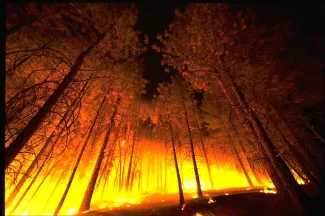
Demers cautions that the public in Altadena or the Palisades isn’t getting the decades-long dose that firefighters do. Even in places like British Columbia, where wildland firefighters can breathe weeks of smoke with nothing but bandanas over their mouths for protection, there are clearly respiratory effects, but whether that translates to a higher risk of cancer is “hard to show.” Cancer takes decades to develop, and without long-term data on air quality and exposure after wildfire, it’s hard to say.
Cancer isn’t the only potential health risk. Air pollution may also damage bone in the long term. In a recent study of postmenopausal women, exposure to sulfur dioxide, a gas that billows from wildfire smoke plumes in both urban and rural areas, was associated with reduced bone mineral density, a biomarker of bone health and predictor of fractures (6). The study assessed about 500 metabolites of bone health and found that some were affected by air pollution. For example, exposure to sulfur dioxide led to decreased levels of the metabolite C-38:4 phosphatidylethanolamine, offering “the first evidence for mechanism of damage,” says coauthor Diddier Prada, an environmental and molecular epidemiologist at the Icahn School of Medicine at Mount Sinai in New York.
Even after the smoke clears, toxins remain in the ash. Not even air quality indices are reliable in such cases, Rice says, because they report particulate matter near a monitoring station. The burn zone “can be a very different story,” she explains, with persistent VOCs and other toxins kicked up by the cleanup effort. The field needs longer-term data on the consequences of prolonged or repeat exposure, Rice says, especially to whatever lurks in the charred debris left behind. The LA Fire HEALTH Study is a start to that work. It’s some of the first research to measure detailed air chemistry at fine temporal and spatial scales for individual houses, according to Misztal. “There’s a lot of fundamentals we’re learning,” he says. One recent data brief, from late August, made headlines after reports of elevated levels of toxic chromium-6 were detected in the air around the debris cleanup zones (7).
“Just being able to see a smoke plume,” Rice says “isn’t necessarily a good indicator” of whether the air is toxic, or for how long. “What are the health effects in the long term for kids and adults? We’re lacking these long-term health studies for the general population.”
Amy McDermott wrote this article for the Proceedings of the National Academy of Sciences.


